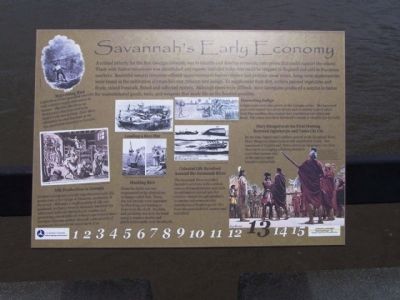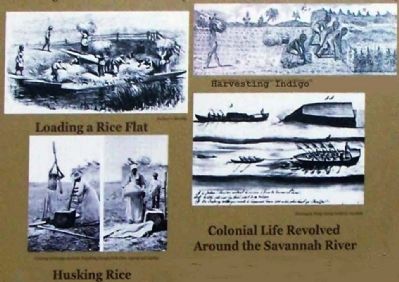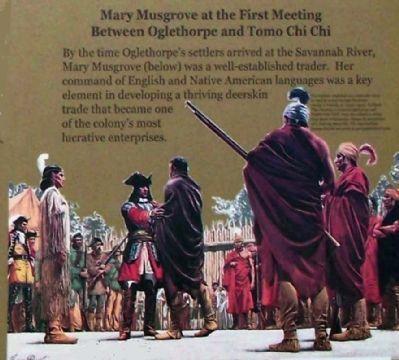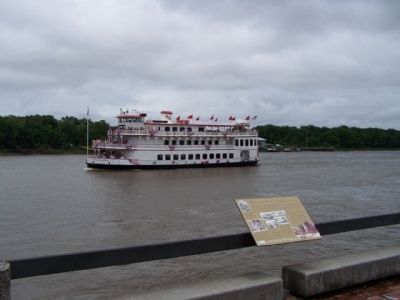Hitch Village/Fred Wessels Homes in Savannah in Chatham County, Georgia — The American South (South Atlantic)
Savannah's Early Economy
A critical priority for the first Georgia colonists was to identify and develop economic enterprises that could support the colony. Trade with native Americans was established and exports included hides that could be shipped to England and sold in European markets. Bountiful natural resources offered opportunities to harvest timber and produce navel stores. Long-term opportunities were found in the cultivation of crops like rice, tobacco and indigo. To supplement their diet, settlers planted vegetables and fruits, raised livestock, fished and collected oysters. Although times were difficult, most Georgians produced a surplus to barter for manufactured goods, tools, and weapons that made life on the frontier possible.
Harvesting Rice
Cultivation of rice provided colonists with a dietary staple and source of income. Marshes like those on Hutchinson Island proved to be ideal for rice production. Slave labor ultimately formed the basis of the rice plantation economy in Georgia.
Silk Production in Georgia
German immigrants initially experimented with silk production at the village of Ebenezer, northwest of Savannah. Although a small quantity of silk was produced, mulberry trees (a necessary foodstuff for silkworms) suffered during harsh weather and processing proved difficult without experienced labor. Georgia's German settlers shipped 1,500 pounds of cocoons to Savannah for spinning in 1751.
Loading a Rice Flat
Husking Rice
From the fields rice was transported to the plantations in barges called flats. There, the rice kernels were separated by threshing and fanning to blow away the chaff. Husking and polishing was done by hand using a wooden mortar and pestle before mills were developed.
Colonial Life Revolved around the Savannah River
The Savannah River provided Georgia's colonists with a critical avenue of transportation and trade. As settlements spread into the interior, vessels brought products to market and returned with manufactured English goods. The river also provided fish, oysters and waterfowl.
Harvesting Indigo
Indigo plants were also grown in the Georgia colony. The harvested parts were soaked in a series of vats and eventually turned into a thick blue pudding-like product that was formed into cakes and dried. These cakes were later dissolved to create a valuable dye for cloth.
Mary Musgrove at the First Meeting Between Oglethorpe and Tomo Chi Chi
By the time Oglethorpe's settlers arrived at the Savannah River, Mary Musgrove (below) was a well established trader. Her command of English and Native American languages was a key element in developing a thriving deerskin
trade that became one of the colony's most lucrative enterprises.
Erected 2009 by U.S. Dept. of Transportation Federal Highway Administration, Georgia Dept. of Transportation. (Marker Number 13.)
Topics. This historical marker is listed in these topic lists: Agriculture • Colonial Era • Industry & Commerce • Native Americans • Settlements & Settlers • Waterways & Vessels. A significant historical year for this entry is 1751.
Location. 32° 4.781′ N, 81° 4.977′ W. Marker is in Savannah, Georgia, in Chatham County. It is in Hitch Village/Fred Wessels Homes. Marker is on East River Street, on the left when traveling east. East of E. Broad St. Ramp, Riverside. Touch for map. Marker is in this post office area: Savannah GA 31401, United States of America. Touch for directions.
Other nearby markers. At least 8 other markers are within walking distance of this marker. Savannah's Liberty Ships and the Atlantic Bridge (within shouting distance of this marker); Native Americans on the Georgia Coast (within shouting distance of this marker); 1996 Olympic Yachting Cauldron (about 300 feet away, measured in a direct line); Crossing the Savannah (about 400 feet away); King Cotton (about 400 feet away); Old Harbor Light (about 500 feet away); The Trustees' Garden (about 500 feet away); Ironclads and Gunboats of the Savannah River Squadron (about 500 feet away). Touch for a list and map of all markers in Savannah.
Credits. This page was last revised on February 8, 2023. It was originally submitted on May 31, 2009, by Mike Stroud of Bluffton, South Carolina. This page has been viewed 2,381 times since then and 57 times this year. Photos: 1, 2, 3, 4. submitted on May 31, 2009, by Mike Stroud of Bluffton, South Carolina. • Craig Swain was the editor who published this page.



